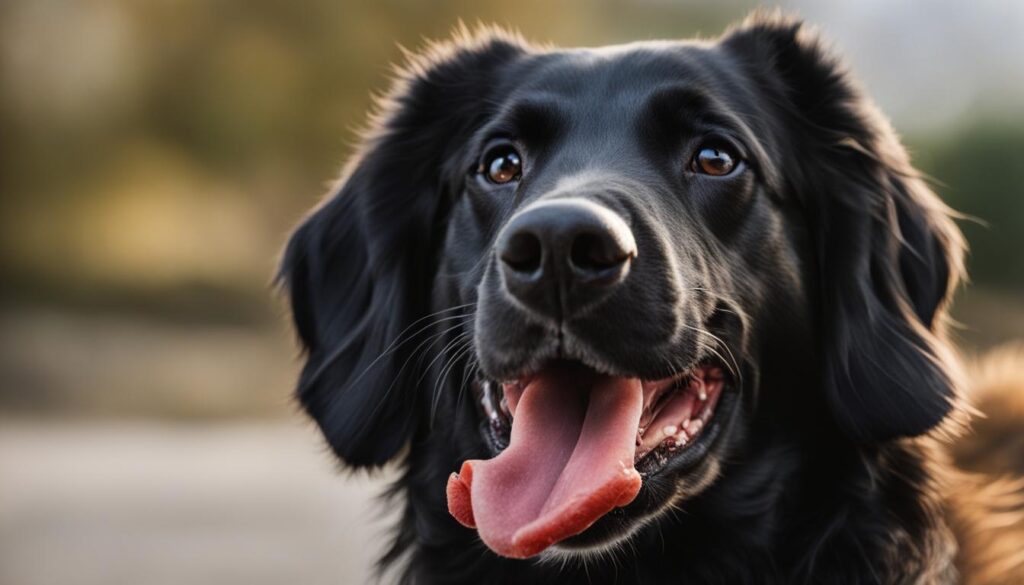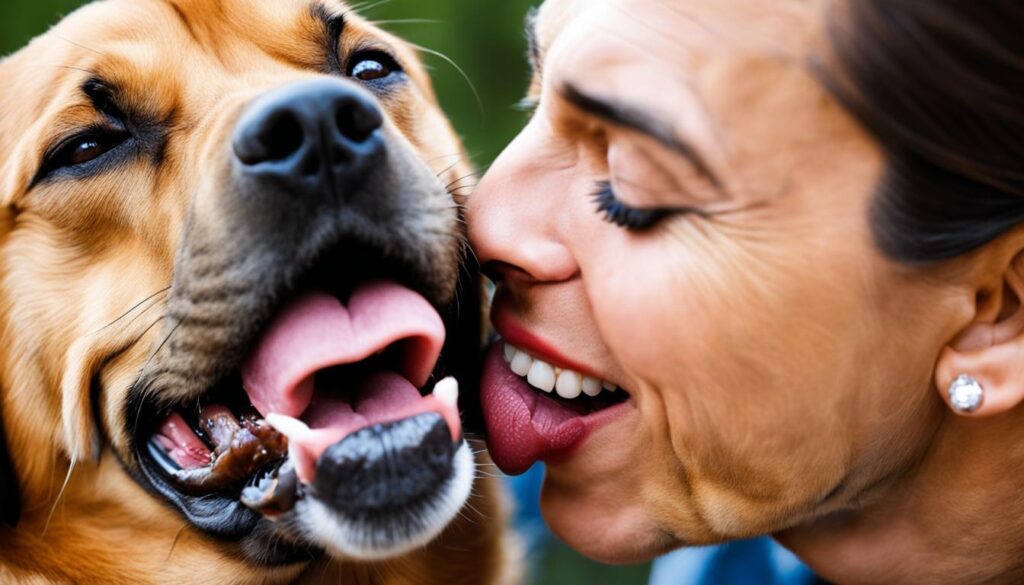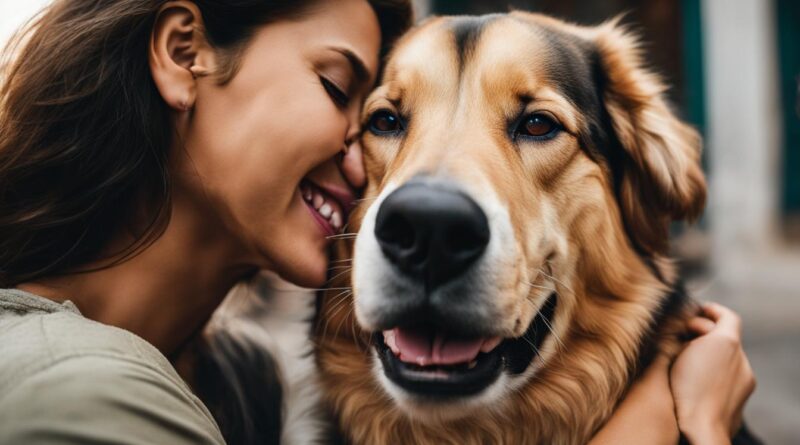Why Does My Dog Lick My Face? Uncover Reasons.
If you’ve ever wondered why your dog licks your face, you’re not alone. This common behavior often leaves dog owners curious about its meaning and purpose. While there is no one definitive answer, understanding the reasons behind this behavior can provide insights into dog behavior psychology, canine communication, and the unique bond between dogs and humans.
Dogs licking our faces can serve various purposes, including communication, affection, seeking attention, and more. By delving into the psychology of dog behavior, we can uncover the motivations behind this seemingly peculiar habit.
Key Takeaways:
- Dogs may lick our faces to communicate affection, seek attention, or groom us.
- This behavior is rooted in their instinctual nature and is a way for dogs to establish friendly intentions.
- Licking can also be a sign of respect and submission towards their human counterparts.
- In some cases, dogs may lick people to request space or relieve stress.
- Understanding and interpreting your dog’s body language and context is crucial in deciphering the meaning behind their licking behavior.
Dog Licking Is an Instinctual Behavior
Licking is an instinctual behavior in dogs that can be traced back to their wild ancestors. Wolf and wild dog cubs lick their mother’s face to stimulate food delivery through regurgitation. Domestic dogs have inherited this behavior and use licking as a way to communicate friendliness and non-threatening intentions to humans. Puppies learn that licking their owners leads to positive outcomes like attention, affection, and play, reinforcing this behavior.
In the wild, wolf and wild dog cubs lick their mother’s face to stimulate regurgitation and receive food. This behavior is rooted in survival instincts and is an essential part of their early development. Domestic dogs have retained this instinct and extend it to their relationship with humans.
When a dog licks your face, they are displaying a friendly gesture and attempting to communicate their intentions. It serves as a non-threatening behavior that is ingrained in their canine communication repertoire.
Importance of Licking in Dog-Human Bond
This instinctual behavior plays a significant role in the dog-human bond. Dogs learn from a young age that licking their owners can elicit positive responses and outcomes. When owners respond with attention, affection, or play, it reinforces the dog’s belief that licking is a desired behavior.
“Dog licking behavior is an inherited instinct that domestic dogs use to communicate friendliness and non-threatening intentions to humans.”
Furthermore, this behavior promotes a sense of connection and reinforces the bond between dogs and their human companions. It establishes trust, affection, and a mutual understanding, creating a harmonious relationship.
Understanding the instinctual nature of dog licking behavior allows us to appreciate the depth of canine communication and the unique ways in which our furry friends express themselves.
Canine Psychology Behind Licking
Dog behavior psychology also sheds light on the reasons for dog licking. The act of licking releases endorphins, the feel-good hormones, which can help dogs feel more relaxed and reduce stress. This natural way of self-soothing contributes to their overall well-being.
Additionally, licking is seen as a grooming behavior in dogs. Puppies learn from their mothers that licking is an essential part of hygiene, stimulating bowel, and bladder movement and cleaning their bodies. Dogs may extend this grooming behavior to humans as a form of care and affection.
It is important to recognize that dog licking behavior can vary among individuals. Some dogs may lick excessively, while others may exhibit more restrained behavior. Factors such as breed, personality, and individual preferences contribute to the variation in licking habits.
Comparative Analysis of Dog Licking Behavior
| Licking Behavior | Implications |
|---|---|
| Excessive Licking | Potential signs of stress, anxiety, or compulsive behavior |
| Moderate Licking | Healthy and natural grooming behavior; expression of affection |
| Rare Licking | Individual preference; may not be a common behavior for that particular dog |
Understanding the nuances of dog licking behavior allows us to better interpret and respond to our furry companions. By observing their body language, context, and other cues, we can foster a deeper connection and ensure their emotional well-being.
Dog Licking Is a Sign of Affection
Dogs licking our faces can be seen as a sign of affection. Just like how dogs lick each other’s faces as a gentle approach to indicate friendly intentions, they do the same with humans. When a dog licks our face and receives a positive response like laughter, petting, or attention, it creates a positive emotional association, which is often perceived as love. This licking behavior may also be a form of appeasement, indicating non-threatening intentions and seeking acceptance.
Table: Reasons for Dog Licking
| Reason | Description |
|---|---|
| Affection | Dogs lick as a sign of love and to seek acceptance. |
| Communication | Licking is a way for dogs to express friendly intentions. |
| Grooming | Similar to how dogs clean themselves, they may lick us to groom. |
| Attention-Seeking | Dogs lick faces to get our attention and initiate interaction. |
“A dog’s lick is their way of saying ‘I love you’ and seeking approval.”
When dogs lick our faces, it is important to understand that they are trying to communicate their affection and bond with us. By reciprocating their love, we strengthen our connection with them and build a deeper understanding. However, it is equally important to set boundaries and redirect the behavior if it becomes excessive or undesirable.
Dog Licking Is an Attention-Seeking Behavior
Dogs often lick our faces as a way to seek attention. Licking gets our attention, whether it’s a joyous response or a displeased one. Dogs may use licking as a means to initiate play or to get their owners to engage with them. However, it’s important to consider the context of the licking behavior and observe other body language cues to determine if the dog is genuinely seeking attention or trying to communicate something else.
Signs of Attention-Seeking Licking
When a dog licks your face, pay attention to their overall behavior. If they show signs of excitement, such as wagging tail, jumping up and down, or a playful stance, it’s likely that they are seeking attention and trying to engage with you. However, if the licking is accompanied by other signs of stress or anxiety, such as a tucked tail, cowering posture, or avoiding eye contact, it may indicate that they’re trying to communicate something else, such as fear or discomfort.
Setting Boundaries
While licking can be a way for dogs to express their affection and seek attention, it’s important to set boundaries and determine what level of licking is acceptable for you. If you find the licking behavior excessive or uncomfortable, you can train your dog to redirect their attention to more appropriate behaviors, such as sitting or giving a handshake, when seeking attention. Rewarding these alternative behaviors can help teach your dog that there are other ways to get your attention.
“Dogs often lick our faces as a way to seek attention.”
Additionally, providing your dog with enough mental and physical stimulation throughout the day can help reduce attention-seeking behaviors. Regular play sessions, training exercises, and interactive toys can keep your dog engaged and satisfied, decreasing the need for excessive licking as a way to seek attention.
Training Tips
Here are some training tips to address attention-seeking licking:
- Consistency is key. Be consistent with your responses to the licking behavior to avoid confusion.
- Redirect their behavior. Teach your dog an alternative behavior, such as sitting or lying down, that can be used to initiate attention or play.
- Reward desired behaviors. When your dog engages in the alternative behavior instead of licking, reward them with praise, treats, or play.
- Ignore the licking. If your dog’s licking is mainly attention-seeking and not causing any harm, try ignoring the behavior. With time, they may learn that licking doesn’t result in the desired attention.
Remember, each dog is unique, and their licking behavior may vary. It’s important to understand your dog’s individual needs and preferences while ensuring a healthy and balanced dog-human relationship.
| Common Reasons for Attention-Seeking Licking | What to Do |
|---|---|
| Lacking mental and physical stimulation | Provide regular play sessions, training exercises, and interactive toys to keep your dog engaged. |
| Seeking interaction or play | Train your dog to redirect their attention to a more appropriate behavior, such as sitting or giving a handshake, when seeking attention. |
| Not receiving enough attention or quality time | Make sure to spend dedicated time with your dog, engaging in activities they enjoy and providing plenty of affection. |
| Seeking reassurance or comfort | Ensure your dog feels secure and loved by maintaining a consistent routine, providing a safe environment, and offering positive reinforcement. |
Dog Licking Is an Attempt To Get Space
In some cases, dogs may lick people to request space. When a dog is licking a person while exhibiting signs of discomfort like dilated pupils, a tucked tail, or turning their head or body away, it can be a signal that they want the person to move away. This behavior, known as “kiss to dismiss,” is a way for dogs to control their proximity to individuals, especially in potentially stressful situations or when interacting with young children.
Owners should intervene and gently redirect the dog’s attention or remove the child or adult from the situation. It’s important to respect the dog’s boundaries and provide them with the space they need to feel comfortable and secure.

Understanding the reasons behind dog licking behavior can help improve the dog-human bond and ensure a harmonious interaction between the two. By recognizing the various motivations behind this behavior, owners can respond appropriately and create a positive environment for their furry companions.
Dog Licking Is a Stress-Reliever
Dogs may engage in excessive licking as a means of relieving stress or anxiety. If your dog is struggling with stress or anxiety, they may engage in continuous licking, often targeting a specific texture like a rug or a couch. This intentional licking behavior promotes the release of endorphins, helping your dog feel more at ease.
To redirect the licking behavior and provide alternative stress relief, consider offering products like the LickiMat® or LickiMat® Wobbler Bowl. These innovative and interactive products are designed to hold wet dog food, peanut butter, or yogurt. The slow licking process required to consume the treat engages your dog’s senses, helping them relax and reducing their stress levels.
Creating a soothing environment for your dog can also help alleviate stress-related licking. Keep in mind that each dog is unique, so experimenting with different stress-relief techniques may be necessary to find what works best for your furry friend.

| Stress-Relief Products | Description |
|---|---|
| LickiMat® | A textured mat that allows your dog to lick soft treats, promoting calmness and relaxation. |
| LickiMat® Wobbler Bowl | A bowl-shaped treat dispenser that wobbles and releases treats as your dog licks, providing mental stimulation and stress relief. |
Dog Licking Is Their Way of Grooming
Dogs use licking as a way of grooming themselves and others. From a young age, puppies are groomed by their mothers through licking, stimulating bowel and bladder movement and cleaning them. When dogs groom themselves or each other, they are drawn to scents like ear wax or blood, which they may find either appealing or offensive, leading to licking to eliminate or interact with these scents. Face licking may be a part of the dog’s natural grooming instinct.
| Grooming Behaviors | Description |
|---|---|
| Self-grooming | A dog uses its tongue to clean various parts of its body, including the face, paws, and tail. The rough texture of their tongue helps remove dirt, debris, and loose hair from their fur. |
| Allogrooming | Dogs groom each other as a social bonding behavior. This can involve licking the face, ears, and other grooming activities. |
| Mother-offspring grooming | A mother dog licks her puppies to stimulate excretion and hygiene, as well as to demonstrate care and to establish a bond. |
“Grooming behaviors play a crucial role in maintaining a dog’s cleanliness and overall well-being. Licking is a natural instinct that helps dogs stay clean and remove unwanted scents.”
Conclusion
In conclusion, dog licking behavior serves various purposes and can be attributed to communication, affection, seeking attention, requesting space, stress-relief, and grooming. It is essential to recognize that each dog is unique, and their licking behavior may vary. While it is generally safe for dogs to lick our faces, it is crucial to consider factors such as personal preferences, allergies, or compromised immune systems.
To maintain a healthy dog-human bond, it is important to establish boundaries and redirect the licking behavior if desired. This can be achieved through training and providing alternative outlets for the dog’s needs. Understanding the reasons behind a dog’s licking behavior can help strengthen the bond between humans and their furry companions, fostering love, trust, and understanding.
Whether it’s a gentle show of affection, an attempt to communicate, or simply a way to groom, dog licking behavior is a unique aspect of the dog-human bond. By respecting our dogs’ individuality and catering to their needs, we can ensure a harmonious relationship that benefits both parties involved.
FAQ
Why does my dog lick my face?
Dogs may lick our faces to communicate affection, seek attention, show submission, or groom us.
Is dog licking a sign of affection?
Yes, dogs often lick our faces as a way to show affection and seek positive responses from us.
Does dog licking indicate a desire for attention?
Yes, dogs may lick our faces to get our attention and initiate play or engagement.
Why does my dog lick me when I’m trying to give it space?
In some cases, dogs may lick people to request space and control their proximity to individuals.
Can excessive licking in dogs be a sign of stress or anxiety?
Yes, dogs may engage in excessive licking as a means of relieving stress or anxiety.
Why do dogs lick themselves and others?
Dogs use licking as a way of grooming themselves and others, similar to how their mothers groomed them as puppies.
Should I be concerned about my dog licking my face?
In general, it is safe for dogs to lick our faces, but personal preferences, allergies, or compromised immune systems should be considered. Setting boundaries and providing alternatives can help manage the behavior.
What does dog licking behavior mean for the dog-human bond?
Dog licking behavior contributes to the dog-human bond by fostering love and understanding between dogs and their owners.


